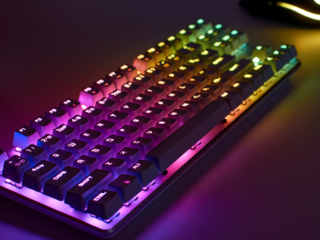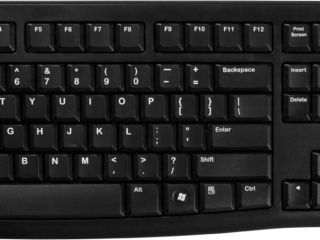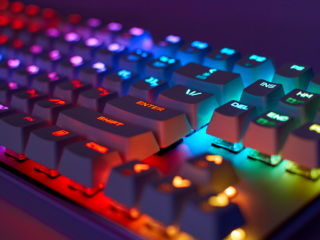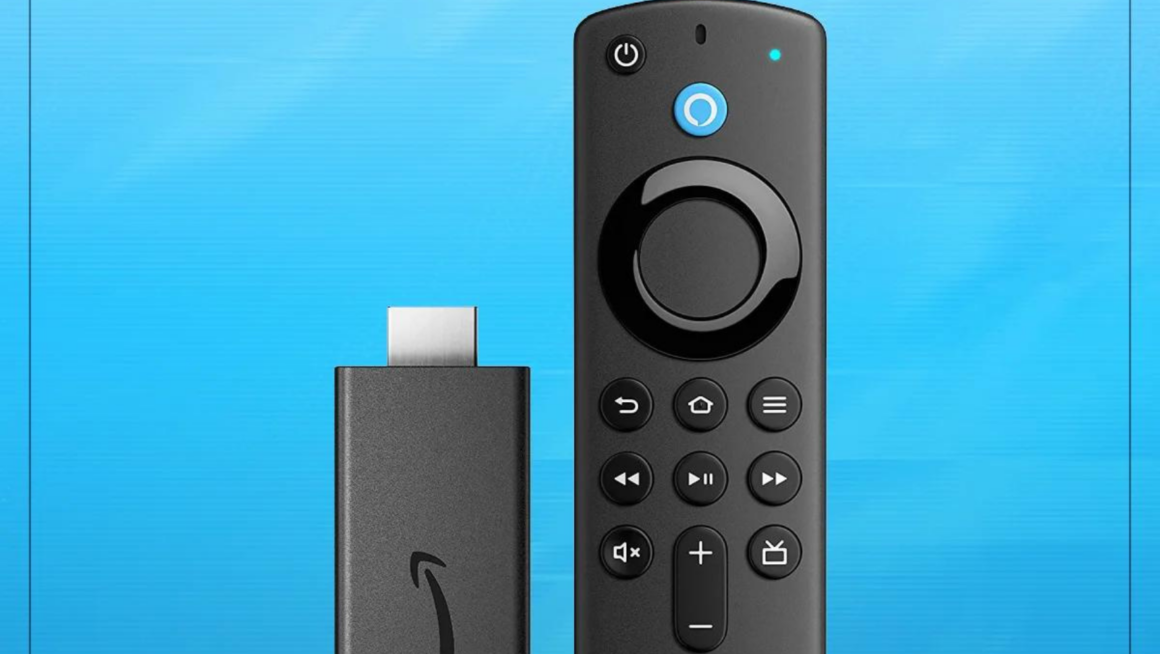In this article, we’ll be taking a look at the different keyboard sizes and what they’re best for.
The keyboard sizes chart is a guide that allows users to see the different keyboard sizes for various devices. It includes keyboards for laptops, tablets, smartphones and more.
So you’ve chosen to go down the mechanical keyboard rabbit hole, but you’re not sure which keyboard sizes are best?
There’s no reason to be concerned.
We’ve tried a variety of keyboards, ranging from full-sized to 60 percent (sorry, 40 percent users, I can’t live without my numbers).
In this post, you’ll discover how to tell the difference between each keyboard size and how to choose the best one for you.
Let’s get started!
What Size Keyboard Should You Get?
 The ideal keyboard size is a matter of personal taste and is largely dependent on your requirements.
The ideal keyboard size is a matter of personal taste and is largely dependent on your requirements.
Here’s a short rundown of what we’ve discovered based on typical keyboard usage:
- Full-Sized Keyboard: Ideal for office employees, particularly those who deal with a lot of numbers and data input. The Numpad is more user-friendly than the Number row.
- 1800 Compact Keyboard: This keyboard is ideal for people who desire the Numpad but want a more compact design. These keyboards are becoming more uncommon, so collectors will relish the opportunity to acquire a high-quality 1800 Compact model.
- TKL Keyboard: Remove the Numpad if you don’t require it. TKL keyboards are ideal for gamers and people who spend a lot of research and typing. Your mouse is closer to your keyboard, which improves the comfort of your setup, particularly for gaming.
- 75 percent Keyboard: This is the best option for individuals who desire a TKL construction in a smaller, more compact package. Choose a 75 percent keyboard if you prefer a more minimalist appearance and want to conserve space.
- The ideal compromise between TKL and 60 percent keyboards is the 65 percent keyboard. If you still use the Arrow keys, it does not contain the Function row but does include the Navigation keys. FPS fans will love it, while MOBA and MMORPG fans will be disappointed.
- If you don’t use the Function row, Numpad, or Navigation keys, this is the ideal minimalist keyboard build for you.
- 40% of the time is spent on the keyboard: This is the keyboard to use if you just want to type. Dual-key functionality is available, but it takes some getting used to.
Terminology for Keyboards
Before we get started, here’s a short rundown of keyboard terms to get you started:
- Using “Alphanumeric” Keys (A-Z, Numbers, Symbols, and so on) to type: The standard A-Z keys, as well as numerals, punctuation, and symbol keys, are all included. Consider your old-fashioned typewriter.
- Control Keys (CTRL, ALT, Delete, Windows Key): These keys may be used alone or in conjunction with other keys to alter your typing.
- Function Keys (F1 – F12): Your keyboard’s F-row, which is situated above the Number row.
- The navigation keys (Arrow Keys, Home, End, Page Up, Page Down, Delete, Insert) are used to navigate through documents or websites.
- Numeric Keypad (Numpad): Your Numpad is used to quickly input numbers.
Microsoft is the source.
Keyboard that is fully sized (100%)
Full-sized keyboards are the way to go if you work in a field that requires a lot of numbers or data entry.
If you enter a lot of numbers on a daily basis, you’ll probably use the Numpad a lot, since it’s quicker than the conventional number row on top of the alphanumeric (typing) keys.
If you’ve ever used a computer, you’ve probably begun with a full-sized keyboard, which is the most popular kind in offices.
Full-sized keyboards are too large for gamers, since the Numpad takes up a lot of room.
The only exception is if you play games that need a large number of keys, in which case having those additional buttons for key bindings or macros would be advantageous.
You can also purchase a TKL keyboard and an external Numpad to place on your left-hand side.
If you’re working with spreadsheets, you’ll be able to utilize the arrow keys for fast navigating.
Keyboard with a compact size of 1800 (ninety-six percent)
All of the keys on a normal full-sized keyboard are included in the 1800 Compact (96 percent) Keyboards, with the exception that they are all bunched together.
Because not all 1800 Compact keyboards come with a full set of keys, double-check that you have all you need before purchasing.
96 percent keyboards are becoming more uncommon, but they are the ideal compromise for people who find the absence of a Numpad bothersome yet don’t want the bulkiness of a full-sized keyboard.
This is an excellent hybrid keyboard for people who game and work on the same computer at the same time.
Tenkeyless (TKL) Keyboard
 Most people prefer TKL keyboards because they eliminate the Numpad, save a lot of work space, and are simpler to travel with due to their smaller size.
Most people prefer TKL keyboards because they eliminate the Numpad, save a lot of work space, and are simpler to travel with due to their smaller size.
Because there is no Numpad, you may move your mouse closer to your keyboard, which is more comfortable and allows you to move and flick your mouse more freely.
TKL keyboards are readily accessible, owing to their increasing popularity over time.
These costs are very reasonable, particularly if you’re looking to get into the mechanical keyboard industry.
In games like CS:GO and VALORANT, TKL keyboards are the recommended keyboard size for most FPS gamers.
75% of the time is spent on the keyboard.
If you enjoy the TKL design but want something even smaller, the 75 percent keyboard is a great option.
75 percent of keyboards are TKL designs with all keys bunched together, allowing for a more compact build and faster typing.
To save on width, 75 percent of keyboards place the Navigation keys close together and align the Home, End, Pg Up, and Pg Down keys vertically.
In terms of usability, there isn’t much of a difference between a TKL and a 75 percent keyboard, so it boils down to personal taste.
If you want to update 75 percent keyboards, you’ll have to spend some additional time searching for custom keycaps since their keys may be various sizes.
In contrast to TKL keyboards, I believe 75% keyboards to be more aesthetically attractive.
65 percent of the time is spent on the keyboard.
The 65 percent keyboard is useful if you seldom use your Function row or Numpad but still want your Navigation keys.
Minimalists and gamers who just want what they use the most will like the 65 percent build.
The 65 percent compact size would help FPS players the most, since it contains everything you need without taking away any important keys.
The absence of Navigation keys, particularly the Arrow keys, may make the keyboard seem too tiny for certain people, therefore a 65 percent build should contain all you need.
The Compact and Separated builds are the two kinds of 65 percent keyboards.
Source: Qisan Magicforce | Keychron K6 (Left) (Right)
Whether you choose the Compact or Separated construction depends on how important smaller form elements are to you.
60% of the time is spent on the keyboard.
Because they are tiny, compact, and visually appealing, 60% of keyboards are the ideal minimalist and enthusiast keyboards.
The 60 percent keyboard construction is the bare-bones, bare-minimum size you need if you don’t utilize your Function keys, Navigation keys, or Numpad.
Keyboards like the Ducky One 2 Mini are popular and well-made, but building your own is less expensive and an excellent way to get started with custom keyboard builds.
It may be too tiny for certain people, particularly if the absence of Arrow keys is a bother.
However, 60% of keyboards include dual-wield capability, enabling you to utilize the Navigation keys while simultaneously holding down the FN button + their corresponding keys.
Here’s how the Ducky One 2 Mini makes advantage of dual-wield functionality:
Ducky One 2 Mini, Ducky One 2 Mini, Ducky One 2 Mini, Ducky One
40% Keyboard
 u/iostream courtesy of r/mechanicalkeyboards
u/iostream courtesy of r/mechanicalkeyboards
40% keyboards are 60% keyboards sans the Number row and offer the ultimate small form-factor keyboard experience.
At first sight, 40 percent keyboards may seem uncomfortable since the Number row appears to be an integral component of any keyboard.
If you respect punctuation and grammar, 40 percent keyboards shine.
Workers who must write documentation or writers who must concentrate on the written word are examples of where this would apply.
These 40% keyboards have minimal finger travel and are the simplest to transport since they are small and lightweight. They also tend to be the most comfortable.
Ortholinear keyboard geometries are more common among 40% of keyboards, which may be more pleasant for certain people.
Here’s an example of a 40 percent Ortholinear keyboard:
40% keyboards are an acquired taste that requires a steeper learning curve to become proficient.
Stick to a 60 percent keyboard or above unless you want the lowest form factor that enables you to type.
A 40 percent keyboard offers little value to gamers since it lacks essential functionality seen in many games, such as the Number row and other crucial punctuation buttons.
Numpad
A Numpad is self-explanatory; it’s a standard Numpad mounted on an external board.
As previously mentioned, having the Numpad on the left side may be more effective since it allows you to place your right hand on the arrow key, which is excellent for people who work with data input and spreadsheets.
If you use the same keyboard for gaming and work, you can get an external Numpad for work and then put it away while you play.
Most Commonly Asked Questions
Some commonly asked questions are included here.
What Is The Standard Computer Keyboard Size?
Because it contains everything you need, any typical cheap functioning keyboard will arrive in full size.
TKL keyboards have grown in popularity over time, owing to the gaming industry’s adoption of smaller form factors.
The majority of the TKL keyboards available are gaming keyboards with mechanical switches.
What Is The Most Appropriate Keyboard Size?
The best-sized keyboard is determined by the function for which it is being used.
There are many variables to consider while selecting the best-sized keyboard, but the list we compiled previously provides a brief overview.
What Is The Width Of A 75% Keyboard?
 75 percent of keyboards are about 12.5″ in length (31.75cm). Their name is self-explanatory, as it refers to the size of a keyboard in comparison to a full-sized keyboard.
75 percent of keyboards are about 12.5″ in length (31.75cm). Their name is self-explanatory, as it refers to the size of a keyboard in comparison to a full-sized keyboard.
A 75% keyboard is equivalent to 75% of a full-sized keyboard.
Here’s a brief rundown of typical keyboard widths:
- 17.4″ Full-Sized Keyboards (44.20cm)
- 15″ Compact: 1800 (38.1cm)
- 14″ TKL (35.56cm)
- 75 percent of 12″ (31.75cm)
- 65 percent of the time: 12″ – 14″ (30.48cm – 35.56cm)
- 60% of the time: 11.5″ (28.21cm)
- Anything under 60%: It varies.
Final Thoughts
You should be able to figure out which keyboard size is best for you by now.
For individuals who use their keyboards for business, a larger keyboard is usually preferable since you employ more of the keyboard’s functionalities.
Smaller form-factor keyboards are preferable for gamers since they provide you more work space and more room to utilize your mouse.
If you use your keyboard for both gaming and business, certain small keyboard sizes are the ideal compromise.
Which keyboard size do you prefer to use? Please let us know in the comments section below!
The 65% keyboard layout is a keyboard size that has been around for a while. It is the most popular one and allows for 65% of the keys to be used on a keyboard.
Frequently Asked Questions
What size is a full size keyboard?
A full size keyboard is the same width as a standard computer keyboard.
Are 60% keyboards better than full size?
This is a difficult question to answer. I am not sure if there are any significant differences between the two, but it would be best to try both out and see which one you like better.
What size keyboard should I get?
The size of a keyboard is dependent on the person. There are many factors that go into how large or small one needs to be, such as hand size, personal preference, and the amount of time spent typing per day.
Related Tags
- keyboard sizes piano
- tkl keyboard dimensions
- 75% keyboard layout
- mechanical keyboard sizes
- full size keyboard



